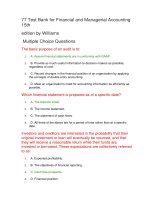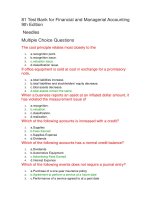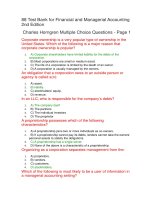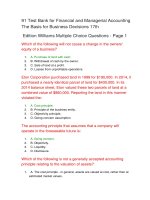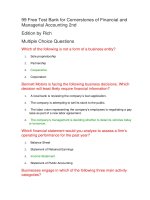Test bank financial and managerial accounting 6th 6e ch01
Bạn đang xem bản rút gọn của tài liệu. Xem và tải ngay bản đầy đủ của tài liệu tại đây (373.84 KB, 125 trang )
Chapter 1
ACCOUNTING IN BUSINESS
True / False Questions
1. Accounting is an information and measurement system that identifies, records, and
communicates relevant, reliable, and comparable information about an organization’s business
activities.
Answer: True
Blooms: Remember
AACSB: Communication
AICPA BB: Industry
AICPA FN: Decision Making
Difficulty: 1 Easy
Learning Objective: 01-C1
Topic: Importance of Accounting
2. Bookkeeping is the recording of transactions and events and is only part of accounting.
Answer: True
Blooms: Remember
AACSB: Communication
AICPA BB: Industry
AICPA FN: Decision Making
Difficulty: 1 Easy
Learning Objective: 01-C1
Topic: Importance of Accounting
3. An accounting information system communicates data to help users make better decisions.
Answer: True
Blooms: Remember
AACSB: Communication
AICPA BB: Industry
AICPA FN: Decision Making
Difficulty: 1 Easy
Learning Objective: 01-C1
Topic: Importance of Accounting
Copyright © 2016 McGraw-Hill Education. All rights reserved. No reproduction or distribution without the prior written consent of
McGraw-Hill Education.
1-1
4. Financial accounting is the area of accounting that provides internal reports to assist the
decision making needs of internal users.
Answer: False
Blooms: Remember
AACSB: Communication
AICPA BB: Industry
AICPA FN: Decision Making
Difficulty: 1 Easy
Learning Objective: 01-C2
Topic: Users of Accounting Information
5. Internal operating activities include research and development, distribution, and human
resources.
Answer: True
Blooms: Remember
AACSB: Communication
AICPA BB: Industry
AICPA FN: Decision Making
Difficulty: 1 Easy
Learning Objective: 01-C2
Topic: Users of Accounting Information
6. The primary objective of managerial accounting is to provide general purpose financial
statements to help external users analyze and interpret an organization’s activities.
Answer: False
Blooms: Remember
AACSB: Communication
AICPA BB: Industry
AICPA FN: Decision Making
Difficulty: 1 Easy
Learning Objective: 01-C2
Topic: Users of Accounting Information
7. External auditors examine financial statements to verify that they are prepared according to
generally accepted accounting principles.
Answer: True
Blooms: Remember
AACSB: Communication
AICPA BB: Industry
AICPA FN: Decision Making
Difficulty: 1 Easy
Learning Objective: 01-C2
Topic: Users of Accounting Information
Copyright © 2016 McGraw-Hill Education. All rights reserved. No reproduction or distribution without the prior written consent of
McGraw-Hill Education.
1-2
8. External users include lenders, shareholders, customers, and regulators.
Answer: True
Blooms: Understand
AACSB: Communication
AICPA BB: Industry
AICPA FN: Decision Making
Difficulty: 2 Medium
Learning Objective: 01-C2
Topic: Users of Accounting Information
9. Regulators often have legal authority over certain activities of organizations.
Answer: True
Blooms: Remember
AACSB: Communication
AICPA BB: Legal
AICPA FN: Decision Making
Difficulty: 1 Easy
Learning Objective: 01-C2
Topic: Users of Accounting Information
10. Internal users include lenders, shareholders, brokers and managers.
Answer: False
Blooms: Understand
AACSB: Communication
AICPA BB: Industry
AICPA FN: Decision Making
Difficulty: 2 Medium
Learning Objective: 01-C2
Topic: Users of Accounting Information
11. Opportunities in accounting include auditing, consulting, market research, and tax
planning.
Answer: True
Blooms: Understand
AACSB: Communication
AICPA BB: Industry
AICPA FN: Decision Making
Difficulty: 2 Medium
Learning Objective: 01-C2
Topic: Users of Accounting Information
Copyright © 2016 McGraw-Hill Education. All rights reserved. No reproduction or distribution without the prior written consent of
McGraw-Hill Education.
1-3
12. Identifying the proper ethical path is usually easy.
Answer: False
Blooms: Understand
AACSB: Ethics
AICPA BB: Industry
AICPA FN: Decision Making
Difficulty: 2 Medium
Learning Objective: 01-C3
Topic: Ethics
13. The Sarbanes-Oxley Act (SOX) requires each issuer of securities to disclose whether it
has adopted a code of ethics for its senior financial officers and the contents of that code.
Answer: True
Blooms: Remember
AACSB: Ethics
AICPA BB: Legal
AICPA FN: Reporting
Difficulty: 1 Easy
Learning Objective: 01-C3
Topic: Ethics
14. The fraud triangle asserts that the three factors that must exist for a person to commit
fraud are opportunity, pressure, and rationalization.
Answer: True
Blooms: Understand
AACSB: Ethics
AICPA BB: Industry
AICPA BB: Legal
AICPA FN: Decision Making
Difficulty: 2 Medium
Learning Objective: 01-C3
Topic: Ethics
15. The Sarbanes-Oxley Act (SOX) does not require public companies to apply both
accounting oversight and stringent internal controls.
Answer: False
Blooms: Understand
AACSB: Ethics
AICPA BB: Legal
AICPA FN: Reporting
Difficulty: 2 Medium
Learning Objective: 01-C4
Topic: Generally Accepted Accounting Principles
Copyright © 2016 McGraw-Hill Education. All rights reserved. No reproduction or distribution without the prior written consent of
McGraw-Hill Education.
1-4
16. A partnership is a business owned by two or more people.
Answer: True
Blooms: Remember
AACSB: Communication
AICPA BB: Legal
AICPA FN: Decision Making
Difficulty: 1 Easy
Learning Objective: 01-C4
Topic: Generally Accepted Accounting Principles
17. Owners of a corporation are called shareholders or stockholders.
Answer: True
Blooms: Remember
AACSB: Communication
AICPA BB: Legal
AICPA FN: Decision Making
Difficulty: 1 Easy
Learning Objective: 01-C4
Topic: Generally Accepted Accounting Principles
18. In the partnership form of business, the owners are called stockholders.
Answer: False
Blooms: Remember
AACSB: Communication
AICPA BB: Legal
AICPA FN: Decision Making
Difficulty: 1 Easy
Learning Objective: 01-C4
Topic: Generally Accepted Accounting Principles
19. The balance sheet shows a company’s net income or loss due to earnings activities over a
period of time.
Answer: False
Blooms: Understand
AACSB: Communication
AICPA BB: Industry
AICPA FN: Reporting
Difficulty: 2 Medium
Learning Objective: 01-P2
Topic: Financial Statements
Copyright © 2016 McGraw-Hill Education. All rights reserved. No reproduction or distribution without the prior written consent of
McGraw-Hill Education.
1-5
20. The Financial Accounting Standards Board is the governmental agency that sets both
broad and specific accounting principles.
Answer: False
Blooms: Understand
AACSB: Communication
AICPA BB: Legal
AICPA FN: Reporting
Difficulty: 2 Medium
Learning Objective: 01-C4
Topic: Generally Accepted Accounting Principles
21. The business entity principle means that accounting information reflects a presumption
that the business will continue operating instead of being closed or sold.
Answer: False
Blooms: Remember
AACSB: Communication
AICPA BB: Industry
AICPA FN: Decision Making
Difficulty: 2 Medium
Learning Objective: 01-C4
Topic: Generally Accepted Accounting Principles
22. Generally accepted accounting principles are the basic assumptions, concepts, and
guidelines for preparing financial statements.
Answer: True
Blooms: Remember
AACSB: Communication
AICPA BB: Industry
AICPA FN: Decision Making
Difficulty: 1 Easy
Learning Objective: 01-C4
Topic: Generally Accepted Accounting Principles
23. The business entity assumption means that a business is accounted for separately from
other business entities, including its owner or owners.
Answer: True
Blooms: Remember
AACSB: Communication
AICPA BB: Industry
AICPA FN: Measurement
Difficulty: 1 Easy
Learning Objective: 01-C4
Topic: Generally Accepted Accounting Principles
Copyright © 2016 McGraw-Hill Education. All rights reserved. No reproduction or distribution without the prior written consent of
McGraw-Hill Education.
1-6
24. As a general rule, revenues should not be recognized in the accounting records when
earned, but rather when cash is received.
Answer: False
Blooms: Understand
AACSB: Communication
AICPA BB: Industry
AICPA FN: Measurement
Difficulty: 2 Medium
Learning Objective: 01-C4
Topic: Generally Accepted Accounting Principles
25. Specific accounting principles are basic assumptions, concepts, and guidelines for
preparing financial statements and arise out of long-used accounting practice.
Answer: False
Blooms: Remember
AACSB: Communication
AICPA BB: Industry
AICPA FN: Measurement
Difficulty: 2 Medium
Learning Objective: 01-C4
Topic: Generally Accepted Accounting Principles
26. General accounting principles arise from long-used accounting practices.
Answer: True
Blooms: Remember
AACSB: Communication
AICPA BB: Industry
AICPA FN: Measurement
Difficulty: 1 Easy
Learning Objective: 01-C4
Topic: Generally Accepted Accounting Principles
27. A sole proprietorship is a business owned by one or more persons.
Answer: False
Blooms: Remember
AACSB: Communication
AICPA BB: Legal
AICPA FN: Decision Making
Difficulty: 1 Easy
Learning Objective: 01-C4
Topic: Generally Accepted Accounting Principles
Copyright © 2016 McGraw-Hill Education. All rights reserved. No reproduction or distribution without the prior written consent of
McGraw-Hill Education.
1-7
28. Unlimited liability and separate taxation of the business are advantages of a sole
proprietorship.
Answer: False
Blooms: Understand
AACSB: Communication
AICPA BB: Legal
AICPA FN: Decision Making
Difficulty: 2 Medium
Learning Objective: 01-C4
Topic: Generally Accepted Accounting Principles
29. Understanding generally accepted accounting principles is not necessary to effectively use
and interpret financial statements.
Answer: False
Blooms: Understand
AACSB: Communication
AICPA BB: Industry
AICPA FN: Decision Making
Difficulty: 2 Medium
Learning Objective: 01-C4
Topic: Generally Accepted Accounting Principles
30. The International Accounting Standards board (IASB) has the authority to impose its
standards on companies around the world.
Answer: False
Blooms: Understand
AACSB: Communication
AICPA BB: Global
AICPA FN: Reporting
Difficulty: 2 Medium
Learning Objective: 01-C4
Topic: Generally Accepted Accounting Principles
31. Objectivity means that financial information is supported by independent, unbiased
evidence.
Answer: True
Blooms: Remember
AACSB: Communication
AICPA BB: Industry
AICPA FN: Measurement
Difficulty: 1 Easy
Learning Objective: 01-C4
Topic: Generally Accepted Accounting Principles
Copyright © 2016 McGraw-Hill Education. All rights reserved. No reproduction or distribution without the prior written consent of
McGraw-Hill Education.
1-8
32. The idea that a business will continue to operate instead of being closed or sold underlies
the going-concern assumption.
Answer: True
Blooms: Remember
AACSB: Communication
AICPA BB: Industry
AICPA FN: Measurement
Difficulty: 1 Easy
Learning Objective: 01-C4
Topic: Generally Accepted Accounting Principles
33. According to the cost principle, it is necessary for managers to report an approximation of
an asset’s market value upon purchase.
Answer: False
Blooms: Understand
AACSB: Communication
AICPA BB: Industry
AICPA FN: Measurement
Difficulty: 2 Medium
Learning Objective: 01-C4
Topic: Generally Accepted Accounting Principles
34. The monetary unit assumption means that all companies doing business in the United
States must express transactions and events in US dollars.
Answer: False
Blooms: Understand
AACSB: Communication
AICPA BB: Industry
AICPA BB: Global
AICPA FN: Measurement
Difficulty: 2 Medium
Learning Objective: 01-C4
Topic: Generally Accepted Accounting Principles
35. The International Accounting Standards Board (IASB) is the government group that
establishes reporting requirements for companies that issue stock to the public.
Answer: False
Blooms: Understand
AACSB: Communications
AICPA BB: Global
AICPA FN: Measurement
Difficulty: 2 Medium
Learning Objective: 01-C4
Topic: Generally Accepted Accounting Principles
Copyright © 2016 McGraw-Hill Education. All rights reserved. No reproduction or distribution without the prior written consent of
McGraw-Hill Education.
1-9
36. A limited liability company offers the limited liability of a partnership or proprietorship
and the tax treatment of a corporation.
Answer: False
Blooms: Remember
AACSB: Communication
AICPA BB: Legal
AICPA FN: Decision Making
Difficulty: 1 Easy
Learning Objective: 01-C4
Topic: Generally Accepted Accounting Principles
37. The Securities and Exchange Commission (SEC) is a government agency that has legal
authority to establish GAAP.
Answer: True
Blooms: Remember
AACSB: Communication
AICPA BB: Legal
AICPA FN: Reporting
Difficulty: 1 Easy
Learning Objective: 01-C4
Topic: Generally Accepted Accounting Principles
38. The three common forms of business ownership include sole proprietorship, partnership,
and non-profit.
Answer: False
Blooms: Remember
AACSB: Communication
AICPA BB: Legal
AICPA FN: Decision Making
Difficulty: 1 Easy
Learning Objective: 01-C4
Topic: Generally Accepted Accounting Principles
39. The three major types of business activities are operating, financing, and investing.
Answer: True
Blooms: Remember
AACSB: Communication
AICPA BB: Industry
AICPA FN: Decision Making
Difficulty: 1 Easy
Learning Objective: 01-C5
Topic: Business Activities and the Accounting Equation
Copyright © 2016 McGraw-Hill Education. All rights reserved. No reproduction or distribution without the prior written consent of
McGraw-Hill Education.
1-10
40. Planning involves defining an organization’s ideas, goals, and actions.
Answer: True
Blooms: Remember
AACSB: Communication
AICPA BB: Industry
AICPA BB: Critical Thinking
AICPA FN: Decision Making
Difficulty: 1 Easy
Learning Objective: 01-C5
Topic: Business Activities and the Accounting Equation
41. Strategic management is the process of determining the right mix of operating activities
for the type of organization, its plans, and its market.
Answer: True
Blooms: Remember
AACSB: Communication
AICPA BB: Industry
AICPA BB: Critical Thinking
AICPA FN: Decision Making
Difficulty: 1 Easy
Learning Objective: 01-C5
Topic: Business Activities and the Accounting Equation
42. Investing activities are the means an organization uses to pay for resources like land,
buildings, and equipment to carry out its plans.
Answer: False
Blooms: Understand
AACSB: Communication
AICPA BB: Critical Thinking
AICPA FN: Decision Making
Difficulty: 2 Medium
Learning Objective: 01-C5
Topic: Business Activities and the Accounting Equation
43. Investing activities are the acquiring and disposing of resources that an organization uses
to acquire and sell its products or services.
Answer: True
Blooms: Remember
AACSB: Communication
AICPA BB: Industry
AICPA FN: Decision Making
Difficulty: 1 Easy
Learning Objective: 01-C5
Topic: Business Activities and the Accounting Equation
Copyright © 2016 McGraw-Hill Education. All rights reserved. No reproduction or distribution without the prior written consent of
McGraw-Hill Education.
1-11
44. Owner financing refers to resources contributed by creditors or lenders.
Answer: False
Blooms: Remember
AACSB: Communication
AICPA BB: Industry
AICPA FN: Decision Making
Difficulty: 1 Easy
Learning Objective: 01-C5
Topic: Business Activities and the Accounting Equation
45. Revenues are increases in equity from a company’s sales of products and services to
customers.
Answer: True
Blooms: Remember
AACSB: Communication
AICPA BB: Industry
AICPA FN: Measurement
Difficulty: 1 Easy
Learning Objective: 01-A1
Topic: The Accounting Equation
46. A net loss occurs when revenues exceed expenses.
Answer: False
Blooms: Understand
AACSB: Analytic
AICPA BB: Critical Thinking
AICPA FN: Measurement
AICPA FN: Reporting
Difficulty: 2 Medium
Learning Objective: 01-A1
Topic: The Accounting Equation
47. Net income occurs when revenues exceed expenses.
Answer: True
Blooms: Understand
AACSB: Analytic
AICPA BB: Critical Thinking
AICPA FN: Measurement
AICPA FN: Reporting
Difficulty: 2 Medium
Learning Objective: 01-A1
Topic: The Accounting Equation
Copyright © 2016 McGraw-Hill Education. All rights reserved. No reproduction or distribution without the prior written consent of
McGraw-Hill Education.
1-12
48. Liabilities are the owner’s claim on assets.
Answer: False
Blooms: Remember
AACSB: Communications
AICPA BB: Industry
AICPA FN: Measurement
Difficulty: 1 Easy
Learning Objective: 01-A1
Topic: The Accounting Equation
49. Assets are the resources a company owns or controls that are expected to yield future
benefits.
Answer: True
Blooms: Remember
AACSB: Communication
AICPA BB: Industry
AICPA FN: Measurement
Difficulty: 1 Easy
Learning Objective: 01-A1
Topic: The Accounting Equation
50. Dividends are expenses.
Answer: False
Blooms: Understand
AACSB: Communication
AICPA BB: Industry
AICPA FN: Measurement
Difficulty: 2 Medium
Learning Objective: 01-A1
Topic: The Accounting Equation
51. The accounting equation can be restated as: Assets – Equity = Liabilities.
Answer: True
Blooms: Understand
AACSB: Analytic
AICPA BB: Industry
AICPA FN: Measurement
Difficulty: 2 Medium
Learning Objective: 01-A1
Topic: The Accounting Equation
Copyright © 2016 McGraw-Hill Education. All rights reserved. No reproduction or distribution without the prior written consent of
McGraw-Hill Education.
1-13
52. The accounting equation implies that: Assets + Liabilities = Equity.
Answer: False
Blooms: Understand
AACSB: Analytic
AICPA BB: Industry
AICPA FN: Measurement
Difficulty: 2 Medium
Learning Objective: 01-A1
Topic: The Accounting Equation
53. Common stock is an increase in equity from a company’s earnings activities.
Answer: False
Blooms: Remember
AACSB: Analytic
AICPA BB: Critical Thinking
AICPA FN: Measurement
Difficulty: 1 Easy
Learning Objective: 01-A1
Topic: The Accounting Equation
54. Every business transaction leaves the accounting equation in balance.
Answer: True
Blooms: Remember
AACSB: Communication
AICPA BB: Industry
AICPA FN: Measurement
Difficulty: 1 Easy
Learning Objective: 01-P1
Topic: Transaction Analysis
55. An external transaction is an exchange within an entity that may or may not affect the
accounting equation.
Answer: False
Blooms: Remember
AACSB: Communication
AICPA BB: Industry
AICPA FN: Measurement
AICPA FN: Decision Making
Difficulty: 1 Easy
Learning Objective: 01-P1
Topic: Transaction Analysis
Copyright © 2016 McGraw-Hill Education. All rights reserved. No reproduction or distribution without the prior written consent of
McGraw-Hill Education.
1-14
56. From an accounting perspective, an event is a happening that affects the accounting
equation, but cannot be measured.
Answer: False
Blooms: Understand
AACSB: Communication
AICPA BB: Industry
AICPA FN: Decision Making
AICPA FN: Measurement
Difficulty: 2 Medium
Learning Objective: 01-P1
Topic: Transaction Analysis
57. Stockholders’ equity is increased when cash is received from customers in payment of
previously recorded accounts receivable.
Answer: False
Blooms: Understand
AACSB: Analytic
AICPA BB: Critical Thinking
AICPA FN: Measurement
Difficulty: 2 Medium
Learning Objective: 01-P1
Topic: Transaction Analysis
58. A stockholder’s investment in a business normally creates an asset (cash), a liability
(note payable), and stockholders’ equity (investment.)
Answer: False
Blooms: Understand
AACSB: Analytic
AICPA BB: Critical Thinking
AICPA FN: Measurement
Difficulty: 2 Medium
Learning Objective: 01-P1
Topic: Transaction Analysis
59. Return on assets is often stated in ratio form as the amount of average total assets divided
by income.
Answer: False
Blooms: Understand
AACSB: Analytic
AICPA BB: Resource Management
AICPA FN: Measurement
Difficulty: 2 Medium
Learning Objective: 01-A2
Topic: Return on Assets
Copyright © 2016 McGraw-Hill Education. All rights reserved. No reproduction or distribution without the prior written consent of
McGraw-Hill Education.
1-15
60. Return on assets is also known as return on investment.
Answer: True
Blooms: Remember
AACSB: Communication
AICPA BB: Resource Management
AICPA FN: Decision Making
Difficulty: 1 Easy
Learning Objective: 01-A2
Topic: Return on Assets
61. Return on assets is useful to decision makers for evaluating management, analyzing and
forecasting profits, and in planning activities.
Answer: True
Blooms: Understand
AACSB: Communication
AICPA BB: Resource Management
AICPA FN: Decision Making
Difficulty: 2 Medium
Learning Objective: 01-A2
Topic: Return on Assets
62. Arrow’s net income of $117 million and average assets of $1,400 million results in a
return on assets of 8.36%.
Answer: True
Blooms: Apply
AACSB: Analytic
AICPA BB: Resource Management
AICPA FN: Measurement
Difficulty: 2 Medium
Learning Objective: 01-A2
Topic: Return on Assets
Feedback: Return on Assets = Net Income/Average Assets
Return on Assets = $117 million/$1,400 million = 8.36%
63. Return on assets reflects a company’s ability to generate profit through productive use of
its assets.
Answer: True
Blooms: Understand
AACSB: Analytic
AICPA BB: Resource Management
AICPA FN: Measurement
Difficulty: 2 Medium
Learning Objective: 01-A2
Topic: Return on Assets
Copyright © 2016 McGraw-Hill Education. All rights reserved. No reproduction or distribution without the prior written consent of
McGraw-Hill Education.
1-16
64. Risk is the uncertainty about the return we will earn.
Answer: True
Blooms: Remember
AACSB: Reflective Thinking
AICPA BB: Industry
AICPA FN: Risk Analysis
Difficulty: 1 Easy
Learning Objective: 01-A3
Topic: Return and Risk Analysis
65. Generally the lower the risk, the higher the return that can be expected.
Answer: False
Blooms: Understand
AACSB: Reflective Thinking
AICPA BB: Industry
AICPA FN: Risk Analysis
Difficulty: 2 Medium
Learning Objective: 01-A3
Topic: Return and Risk Analysis
66. U. S. Government Treasury bonds provide low return and low risk to investors.
Answer: True
Blooms: Understand
AACSB: Reflective Thinking
AICPA BB: Industry
AICPA BB: Critical Thinking
AICPA FN: Risk Analysis
Difficulty: 2 Medium
Learning Objective: 01-A3
Topic: Return and Risk Analysis
67. The four basic financial statements include the balance sheet, income statement, statement
of retained earnings, and statement of cash flows.
Answer: True
Blooms: Remember
AACSB: Communication
AICPA BB: Industry
AICPA FN: Reporting
Difficulty: 1 Easy
Learning Objective: 01-P2
Topic: Financial Statements
Copyright © 2016 McGraw-Hill Education. All rights reserved. No reproduction or distribution without the prior written consent of
McGraw-Hill Education.
1-17
68. An income statement reports on investing and financing activities.
Answer: False
Blooms: Understand
AACSB: Analytic
AICPA BB: Industry
AICPA FN: Reporting
Difficulty: 2 Medium
Learning Objective: 01-P2
Topic: Financial Statements
69. A balance sheet covers activities over a period of time such as a month or year.
Answer: False
Blooms: Understand
AACSB: Analytic
AICPA BB: Industry
AICPA FN: Reporting
Difficulty: 2 Medium
Learning Objective: 01-P2
Topic: Financial Statements
70. The income statement describes revenues earned and expenses incurred over a specified
period of time due to earnings activities.
Answer: True
Blooms: Remember
AACSB: Analytic
AICPA BB: Industry
AICPA FN: Reporting
Difficulty: 1 Easy
Learning Objective: 01-P2
Topic: Financial Statements
71. The statement of cash flows shows the net effect of revenues and expenses for a reporting
period.
Answer: False
Blooms: Remember
AACSB: Analytic
AICPA BB: Industry
AICPA FN: Reporting
Difficulty: 1 Easy
Learning Objective: 01-P2
Topic: Financial Statements
Copyright © 2016 McGraw-Hill Education. All rights reserved. No reproduction or distribution without the prior written consent of
McGraw-Hill Education.
1-18
72. The income statement shows the financial position of a business on a specific date.
Answer: False
Blooms: Understand
AACSB: Analytic
AICPA BB: Industry
AICPA FN: Reporting
Difficulty: 2 Medium
Learning Objective: 01-P2
Topic: Financial Statements
73. The first section of the income statement reports cash flows from operating activities.
Answer: False
Blooms: Understand
AACSB: Analytic
AICPA BB: Industry
AICPA FN: Reporting
Difficulty: 2 Medium
Learning Objective: 01-P2
Topic: Financial Statements
74. The balance sheet is based on the accounting equation.
Answer: True
Blooms: Understand
AACSB: Analytic
AICPA BB: Industry
AICPA FN: Reporting
Difficulty: 2 Medium
Learning Objective: 01-P2
Topic: Financial Statements
75. Investing activities involve the buying and selling of assets such as land and equipment
that are held for long-term use in the business.
Answer: True
Blooms: Understand
AACSB: Analytic
AICPA BB: Industry
AICPA FN: Reporting
Difficulty: 2 Medium
Learning Objective: 01-P2
Topic: Financial Statements
Copyright © 2016 McGraw-Hill Education. All rights reserved. No reproduction or distribution without the prior written consent of
McGraw-Hill Education.
1-19
76. Operating activities include long-term borrowing and repaying cash from lenders, and
cash investments or dividends to stockholders.
Answer: False
Blooms: Understand
AACSB: Analytic
AICPA BB: Industry
AICPA FN: Reporting
Difficulty: 2 Medium
Learning Objective: 01-P2
Topic: Financial Statements
77. The purchase of supplies appears on the statement of cash flows as an investing activity
because it involves the purchase of assets.
Answer: False
Blooms: Understand
AACSB: Analytic
AICPA BB: Industry
AICPA FN: Reporting
Difficulty: 2 Medium
Learning Objective: 01-P2
Topic: Financial Statements
78. The income statement reports on operating activities at a point in time.
Answer: False
Blooms: Understand
AACSB: Analytic
AICPA BB: Industry
AICPA FN: Reporting
Difficulty: 2 Medium
Learning Objective: 01-P2
Topic: Financial Statements
79. The statement of cash flows identifies cash flows separated into operating, investing, and
financing activities over a period of time.
Answer: True
Blooms: Remember
AACSB: Analytic
AICPA BB: Industry
AICPA FN: Reporting
Difficulty: 1 Easy
Learning Objective: 01-P2
Topic: Financial Statements
Copyright © 2016 McGraw-Hill Education. All rights reserved. No reproduction or distribution without the prior written consent of
McGraw-Hill Education.
1-20
80. Ending retained earnings on the statement of retained earnings is calculated by adding
stockholder investments and net losses and subtracting net income and dividends.
Answer: False
Blooms: Apply
AACSB: Analytic
AICPA BB: Industry
AICPA BB: Critical Thinking
AICPA FN: Reporting
Difficulty: 3 Hard
Learning Objective: 01-P2
Topic: Financial Statements
Multiple Choice Questions
81. Accounting is an information and measurement system that does all of the following
except:
A. Identifies business activities.
B. Records business activities.
C. Communicates business activities.
D. Eliminates the need for interpreting financial data .
E. Helps people make better decisions.
Answer: D
Blooms: Understand
AACSB: Analytic
AICPA BB: Industry
AICPA FN: Decision Making
Difficulty: 2 Medium
Learning Objective: 01-C1
Topic: Importance of Accounting
82. Technology:
A. Has replaced accounting.
B. Has not improved the clerical accuracy of accounting.
C. Reduces the time, effort and cost of recordkeeping.
D. In accounting has replaced the need for decision makers.
E. In accounting is only available to large corporations.
Answer: C
Blooms: Understand
AACSB: Technology
AICPA BB: Industry
AICPA FN: Leveraging Technology
Difficulty: 2 Medium
Learning Objective: 01-C1
Topic: Importance of Accounting
Copyright © 2016 McGraw-Hill Education. All rights reserved. No reproduction or distribution without the prior written consent of
McGraw-Hill Education.
1-21
83. The primary objective of financial accounting is to:
A. Serve the decision-making needs of internal users.
B. Provide accounting information that serves external users.
C. Monitor and control company activities.
D. Provide information on both the costs and benefits of looking after products and services.
E. Know what, when, and how much product to produce.
Answer: B
Blooms: Understand
AACSB: Communication
AICPA BB: Industry
AICPA FN: Reporting
Difficulty: 2 Medium
Learning Objective: 01-C2
Topic: Users of Accounting Information
84. The area of accounting aimed at serving the decision making needs of internal users is:
A. Financial accounting.
B. Managerial accounting.
C. External auditing.
D. SEC reporting.
E. Bookkeeping.
Answer: B
Blooms: Remember
AACSB: Communication
AICPA BB: Industry
AICPA FN: Reporting
Difficulty: 1 Easy
Learning Objective: 01-C2
Topic: Users of Accounting Information
85. External users of accounting information include all of the following except:
A. Shareholders.
B. Customers.
C. Purchasing managers.
D. Government regulators.
E. Creditors.
Answer: C
Blooms: Understand
AACSB: Communication
AICPA BB: Industry
AICPA FN: Reporting
Difficulty: 2 Medium
Learning Objective: 01-C2
Topic: Users of Accounting Information
Copyright © 2016 McGraw-Hill Education. All rights reserved. No reproduction or distribution without the prior written consent of
McGraw-Hill Education.
1-22
86. All of the following regarding a Certified Public Accountant are true except:
A. Must meet education and experience requirements.
B. Must pass an examination.
C. Must exhibit ethical character.
D. May also be a Certified Management Accountant.
E. Cannot hold any certificate other than a CPA.
Answer: E
Blooms: Remember
AACSB: Communication
AICPA BB: Industry
AICPA FN: Decision Making
Difficulty: 1 Easy
Learning Objective: 01-C2
Topic: Users of Accounting Information
87. Ethical behavior requires that:
A. Auditors’ pay not depend on the success of the client’s business.
B. Auditors invest in businesses they audit.
C. Analysts report information favorable to their companies.
D. Managers use accounting information to benefit themselves.
E. Auditors’ pay depends on the success of the client’s business.
Answer: A
Blooms: Understand
AACSB: Ethics
AICPA BB: Legal
AICPA FN: Reporting
Difficulty: 2 Medium
Learning Objective: 01-C3
Topic: Ethics
88. The conceptual framework that the Financial Accounting Standards Board (FASB) and the
International Accounting Standards Board (IASB) are attempting to converge and enhance
includes the following broad areas to guide standard setting except:
A. Objectives
B. Qualitative characteristics
C. Uniformity
D. Elements
E. Recognition and measurement
Answer: C
Blooms: Remember
AACSB: Communication
AICPA BB: Legal
AICPA FN: Decision Making
Difficulty: 2 Medium
Learning Objective: 01-C4
Topic: Generally Accepted Accounting Principles
Copyright © 2016 McGraw-Hill Education. All rights reserved. No reproduction or distribution without the prior written consent of
McGraw-Hill Education.
1-23
89. All of the following are true regarding ethics except:
A. Ethics are beliefs that separate right from wrong.
B. Ethics rules are often set for CPAs.
C. Ethics do not affect the operations or outcome of a company.
D. Are critical in accounting.
E. Ethics can be difficult to apply.
Answer: C
Blooms: Understand
AACSB: Ethics
AICPA BB: Industry
AICPA FN: Decision Making
Difficulty: 2 Medium
Learning Objective: 01-C3
Topic: Ethics
90. The accounting concept that requires financial statement information to be supported by
independent, unbiased evidence is:
A. Business entity assumption.
B. Revenue recognition principle.
C. Going-concern assumption.
D. Time-period assumption.
E. Objectivity principle
Answer: E
Blooms: Remember
AACSB: Communication
AICPA BB: Industry
AICPA BB: Legal
AICPA FN: Measurement
Difficulty: 1 Easy
Learning Objective: 01-C4
Topic: Generally Accepted Accounting Principles
91. A corporation is:
A. A business legally separate from its owners.
B. Controlled by the FASB.
C. Not responsible for its own acts and own debts.
D. The same as a limited liability partnership.
E. Not subject to double taxation.
Answer: A
Blooms: Remember
AACSB: Communication
AICPA BB: Legal
AICPA FN: Decision Making
Difficulty: 1 Easy
Learning Objective: 01-C4
Topic: Generally Accepted Accounting Principles
Copyright © 2016 McGraw-Hill Education. All rights reserved. No reproduction or distribution without the prior written consent of
McGraw-Hill Education.
1-24
92. The independent group that is attempting to harmonize accounting practices of different
countries is the:
A. AICPA.
B. IASB.
C. CAP.
D. SEC.
E. FASB.
Answer: B
Blooms: Remember
AACSB: Communication
AICPA BB: Global
AICPA FN: Reporting
Difficulty: 1 Easy
Learning Objective: 01-C4
Topic: Generally Accepted Accounting Principles
93. The private-sector group that currently has the authority to establish generally accepted
accounting principles in the United States is the:
A. APB.
B. FASB.
C. AAA.
D. AICPA.
E. SEC.
Answer: B
Blooms: Remember
AACSB: Communication
AICPA BB: Industry
AICPA BB: Legal
AICPA FN: Reporting
Difficulty: 1 Easy
Learning Objective: 01-C4
Topic: Generally Accepted Accounting Principles
Copyright © 2016 McGraw-Hill Education. All rights reserved. No reproduction or distribution without the prior written consent of
McGraw-Hill Education.
1-25



